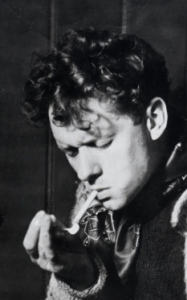 In “Poetics in the Fiction of Dylan Thomas,” published in North of Oxford, Ray Greenblatt notes how in A Child’s Christmas in Wales (1952) “Thomas’ poetic style is revealed in the prose as well: vivid imagery, alliteration, purposeful run-on lines, many adjectives, humor, strong emotions from joy to sadness. In most of these stories Dylan is his own narrator; we even observe him growing up from his pre-teens into a young man in his twenties . . . . Thomas writes impressionistic stories about his life (or at least about a boy named Dylan) in Wales.”
In “Poetics in the Fiction of Dylan Thomas,” published in North of Oxford, Ray Greenblatt notes how in A Child’s Christmas in Wales (1952) “Thomas’ poetic style is revealed in the prose as well: vivid imagery, alliteration, purposeful run-on lines, many adjectives, humor, strong emotions from joy to sadness. In most of these stories Dylan is his own narrator; we even observe him growing up from his pre-teens into a young man in his twenties . . . . Thomas writes impressionistic stories about his life (or at least about a boy named Dylan) in Wales.”
“Dylan Thomas died so young, but in his short life he excelled in poetry and short fiction. One hears echoes of James Joyce in Thomas’ emotional display of young characters’ feelings of love. Thomas would undoubtedly have read this Celtic forerunner whose work began to dominate the world in 1916 with his first novel A Portrait of the Artist as a Young Man. Yet, Thomas’ prose in turn influenced American writers who came after him. J.D. Salinger, in Europe during World War Two, could have read Thomas. Salinger employed American colloquialisms used by the young as Thomas did the British. And another echo is heard in the writing of John Updike who attended Oxford in 1954, just after Thomas’ death. Updike often describes the woodlands and the sea in his work against which young people interact. We can only conjecture what further influences Dylan Thomas might have disseminated to the literary world had he lived longer.”
